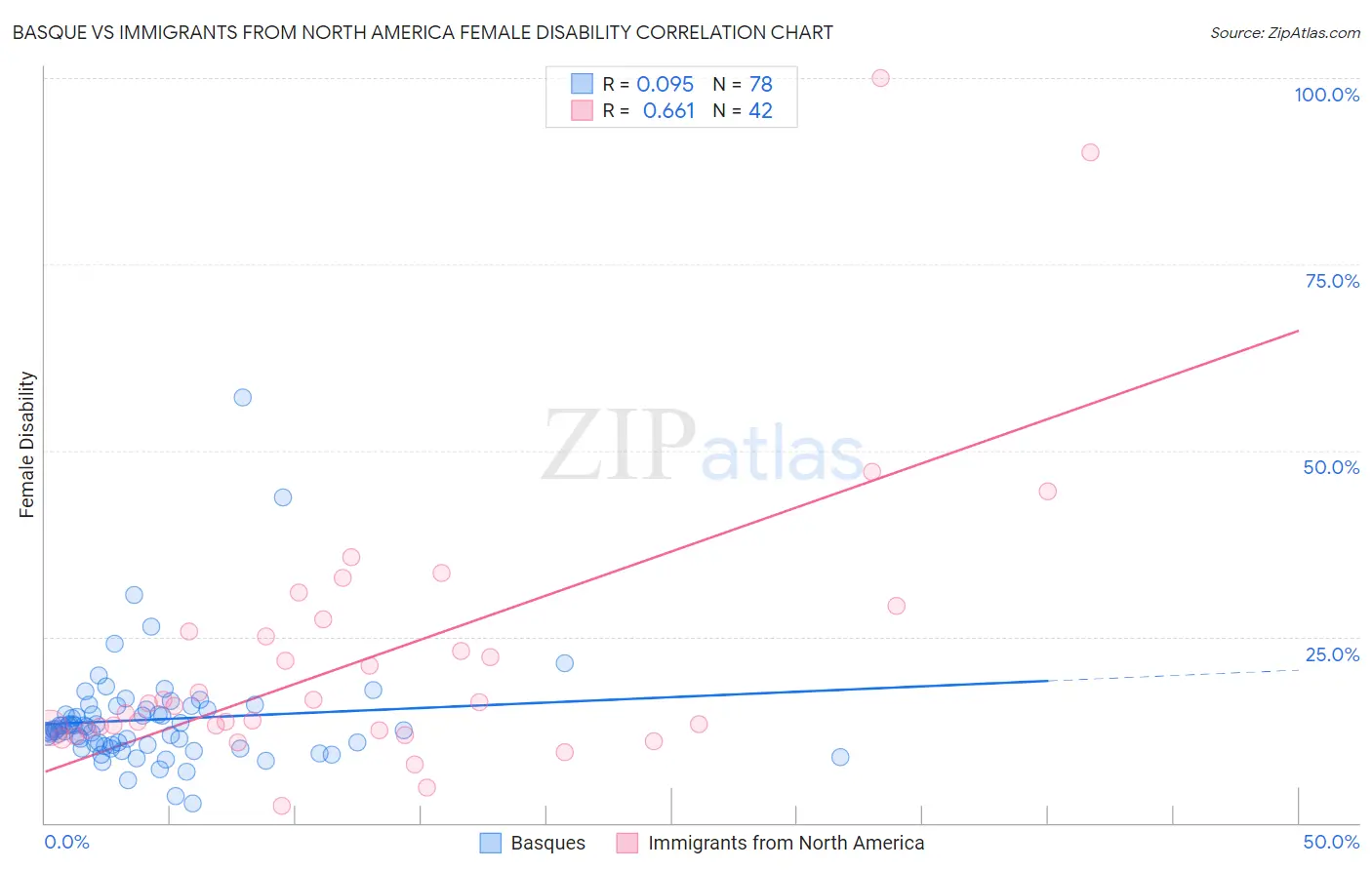Basque vs Immigrants from North America Female Disability
COMPARE
Basque
Immigrants from North America
Female Disability
Female Disability Comparison
Basques
Immigrants from North America
12.4%
FEMALE DISABILITY
17.5/ 100
METRIC RATING
208th/ 347
METRIC RANK
12.3%
FEMALE DISABILITY
32.8/ 100
METRIC RATING
188th/ 347
METRIC RANK
Basque vs Immigrants from North America Female Disability Correlation Chart
The statistical analysis conducted on geographies consisting of 165,775,709 people shows a slight positive correlation between the proportion of Basques and percentage of females with a disability in the United States with a correlation coefficient (R) of 0.095 and weighted average of 12.4%. Similarly, the statistical analysis conducted on geographies consisting of 462,407,592 people shows a significant positive correlation between the proportion of Immigrants from North America and percentage of females with a disability in the United States with a correlation coefficient (R) of 0.661 and weighted average of 12.3%, a difference of 0.78%.

Female Disability Correlation Summary
| Measurement | Basque | Immigrants from North America |
| Minimum | 2.6% | 2.3% |
| Maximum | 57.1% | 100.0% |
| Range | 54.5% | 97.7% |
| Mean | 13.9% | 22.3% |
| Median | 12.6% | 15.9% |
| Interquartile 25% (IQ1) | 10.4% | 12.5% |
| Interquartile 75% (IQ3) | 15.2% | 25.7% |
| Interquartile Range (IQR) | 4.8% | 13.2% |
| Standard Deviation (Sample) | 7.5% | 19.2% |
| Standard Deviation (Population) | 7.4% | 19.0% |
Demographics Similar to Basques and Immigrants from North America by Female Disability
In terms of female disability, the demographic groups most similar to Basques are Immigrants from Cuba (12.4%, a difference of 0.16%), Croatian (12.4%, a difference of 0.16%), Immigrants from Grenada (12.4%, a difference of 0.18%), Immigrants from Zaire (12.3%, a difference of 0.20%), and Immigrants from Barbados (12.3%, a difference of 0.22%). Similarly, the demographic groups most similar to Immigrants from North America are Immigrants from Albania (12.3%, a difference of 0.050%), Immigrants from Honduras (12.3%, a difference of 0.060%), Armenian (12.3%, a difference of 0.13%), Immigrants from Western Africa (12.3%, a difference of 0.15%), and Northern European (12.3%, a difference of 0.23%).
| Demographics | Rating | Rank | Female Disability |
| Immigrants | North America | 32.8 /100 | #188 | Fair 12.3% |
| Immigrants | Albania | 31.6 /100 | #189 | Fair 12.3% |
| Immigrants | Honduras | 31.3 /100 | #190 | Fair 12.3% |
| Armenians | 29.7 /100 | #191 | Fair 12.3% |
| Immigrants | Western Africa | 29.2 /100 | #192 | Fair 12.3% |
| Northern Europeans | 27.5 /100 | #193 | Fair 12.3% |
| Ukrainians | 27.2 /100 | #194 | Fair 12.3% |
| Swedes | 26.6 /100 | #195 | Fair 12.3% |
| Immigrants | Panama | 25.5 /100 | #196 | Fair 12.3% |
| Hondurans | 25.4 /100 | #197 | Fair 12.3% |
| Mexican American Indians | 24.9 /100 | #198 | Fair 12.3% |
| Immigrants | Trinidad and Tobago | 24.7 /100 | #199 | Fair 12.3% |
| Trinidadians and Tobagonians | 22.4 /100 | #200 | Fair 12.3% |
| Chinese | 22.1 /100 | #201 | Fair 12.3% |
| Somalis | 21.5 /100 | #202 | Fair 12.3% |
| Immigrants | Barbados | 21.1 /100 | #203 | Fair 12.3% |
| Immigrants | Zaire | 20.9 /100 | #204 | Fair 12.3% |
| Immigrants | Grenada | 20.5 /100 | #205 | Fair 12.4% |
| Immigrants | Cuba | 20.2 /100 | #206 | Fair 12.4% |
| Croatians | 20.2 /100 | #207 | Fair 12.4% |
| Basques | 17.5 /100 | #208 | Poor 12.4% |